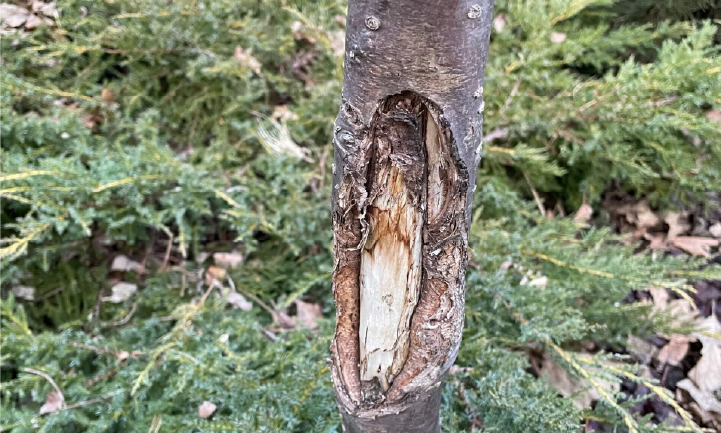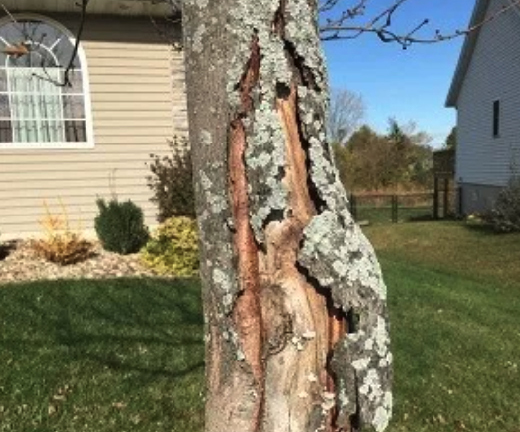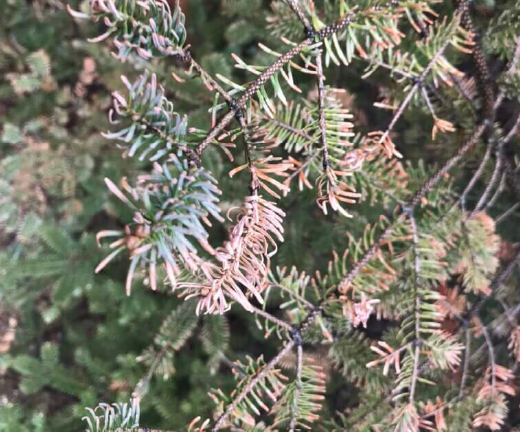
Winter in Minnesota provides many challenges for trees and shrubs, from extreme cold to dry winds and even the sun. Bright, sunny days can pose as much, or even more risk to some plants. The main issues we see later in winter are sunscald and winter burn. Both of these issues are best treated with prevention, as once the damage occurs there’s very little we can do.
Sunscald is damage to the trunks of trees, particularly on the southwest side, from solar heating. Think of it sort of like sunburn on the trunk: the sun heats up the bark with direct sunlight and reflected light off the snow, windows, or light-colored surfaces nearby. This heating causes the bark to warm up above freezing, which causes the bark to wake up and break dormancy. The process of bark hardening off and going dormant is a slow one and can’t happen in time for the inevitable re-freeze that happens the following evening. The now-awake bark cells freeze and rupture, which causes a sunken area of dead bark.
The following spring, the tree will try to seal over the damaged area from the still-alive edges. The photo above shows the wound wood developing from the margins, in an attempt to cover the wound. If the wound is small and the tree is able to seal it quickly, it may never be an issue again. Likely, a frost crack will develop, or the tree will struggle to move enough nutrients and decline.
Preventing the sun from heating up the bark to the point of breaking dormancy is the best way to avoid sunscald, and there are several ways to do so. The most common is wrapping the trunk with white paper to reflect the light away. The wrap should be applied in the fall after the leaves have fallen and removed in the spring when the buds begin to open. Orchards and other areas where trees are grown as a crop and not for aesthetic reasons will often simply paint the trunks white, to avoid the hassle of wrapping and unwrapping every winter. Another creative option is to plant something near the trunk of a tree, to shade it in the winter.


The warm, late winter sun can also cause problems with evergreens called winter burn or winter desiccation (drying out). As with sunscald, the sun can warm up the leaves or needles of evergreens to the point they begin to photosynthesize. If we think back to our basic plant biology, leaves use water, nutrients, CO2, and sunshine to make their food. If the roots can’t absorb water from the frozen ground, that system begins to fail. As photosynthesizing continues to take place, the drying out (desiccation) of the needles/leaves begins to occur which can cause browning and needle/leaf death. The wind is also a factor here, as a dry breeze will cause the leaves to dry out even faster.
Some plants have adapted to the risk of winter burn by withdrawing chlorophyll into the brown branches during the winter to prevent photosynthesis. This often causes the needles or leaves to turn a purplish color, as the other pigments stay in place. An example of this is the small volunteer junipers that sprout up along fence lines in the Great Plains. Their rusty purple color is visible from highways in Nebraska and Kansas.
For plants that don’t have this adaptation, we need to provide them some protection. Wrapping them with burlap can help block the wind, as well as reduce how much sunlight hits the leaves. As with trunk wrapping for sunscald, apply burlap in the fall and remove it in the spring. The best prevention is to place sensitive plants in sheltered areas.
No issue is ever 100% preventable, but the risk of sunscald and winter burn can be reduced with a small amount of effort. Our ISA Certified Master Arborists can help mitigate the damage of winter on your trees. For hands-on help, we would be happy to refer you to one of our trusted landscape maintenance partners.
From questions to estimate requests, contact us about your residential or commercial project.